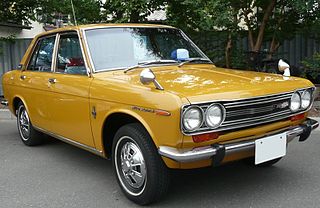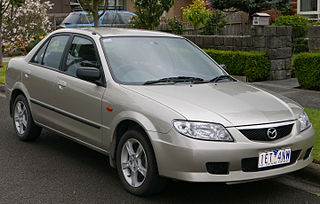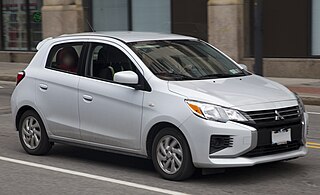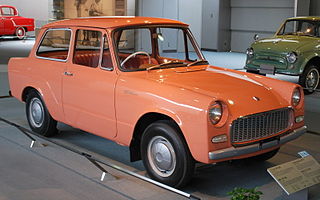
The Datsun 510 was a series of the Datsun Bluebird sold from 1968 to 1973, and offered outside the U.S. and Canada as the Datsun 1300/1400/1500/1600/1800.

The Mitsubishi Galant is an automobile which was produced by Japanese manufacturer Mitsubishi from 1969 until 2012. The model name was derived from the French word galant, meaning "chivalrous". There have been nine distinct generations with total cumulative sales exceeding five million units. It began as a compact sedan, but over the course of its life evolved into a mid-size car. Initial production was based in Japan, with manufacturing later moved to other countries.

The Mazda Familia, also marketed prominently as the Mazda 323, Mazda Protegé and Mazda Allegro, is a small family car that was manufactured by Mazda between 1963 and 2003. The Familia line was replaced by the Mazda3/Axela for 2004.

The Nissan Bluebird is a compact car produced between 1955 and 2007 with a model name introduced in 1957. It was Nissan's most internationally recognized sedan, known for its dependability and durability in multiple body styles. The Bluebird originated from Nissan's first vehicles, dating to the early 1900s, and its traditional competitor became the Toyota Corona. The Bluebird was positioned to compete with the Corona, as the Corona was developed to continue offering a sedan used as a taxi since the Toyota Crown was growing in size. Every generation of the Bluebird has been available as a taxi, duties that are shared with base level Nissan Cedrics. It is one of the longest-running nameplates from a Japanese automaker. It spawned most of Nissan's products sold internationally, and has been known by a number of different names and bodystyles, including the Auster/Stanza names.

The Nissan Sunny is an automobile built by the Japanese automaker Nissan from 1966 till 2004. In the early 1980s, the brand changed from Datsun to Nissan in line with other models by the company. Although production of the Sunny in Japan ended in 2004, the name remains in use in China and GCC countries for a rebadged version of the Nissan Almera.

The Opel Rekord is a large family car which was built in eight generations by the German car manufacturer Opel. Between 1953 and 1986, approximately ten million were sold.

The Mitsubishi Colt is a nameplate from Mitsubishi Motors that has been applied to a number of automobiles since 1962. It was first introduced with a series of kei and subcompact cars in the 1960s, and then for the export version of the subcompact Mirage between 1978 and 2002. Chrysler, Mitsubishi's longtime partner, also used the name when applying its long-running practice of rebadging Mitsubishi vehicles as the Dodge and Plymouth Colt captive imports for the North American market between 1970 and 1994.

The Daihatsu Fellow Max is a small Japanese automobile in the Kei car class. Originally introduced as the Daihatsu Fellow, the name was partially retained for its successor, the Max Cuore (1977), and then revived in 2000 for the Daihatsu Max.

The Mitsubishi Mirage is a range of cars produced by the Japanese manufacturer Mitsubishi from 1978 until 2003 and again since 2012. The hatchback models produced between 1978 and 2003 were classified as subcompact cars, while the sedan and station wagon models, marketed prominently as the Mitsubishi Lancer, were the compact offerings. The liftback introduced in 1988 complemented the sedan as an additional compact offering, and the coupé of 1991 fitted in with the subcompact range. The current Mirage model is a subcompact hatchback and sedan and it replaces the Mitsubishi Colt sold between 2002 and 2012.

The Mitsubishi Minica is a model series of kei cars, produced by Mitsubishi Motors Corp. (MMC) over five generations, from 1962 to 2011, mainly for the Japanese domestic market.

The Mitsubishi Chariot is an automobile manufactured and marketed by Mitsubishi from 1983 to 2003. It is a small multi-purpose vehicle (MPV). Based on the SSW concept car first exhibited at the 23rd Tokyo Motor Show in 1979, the MPV derives its nameplate from chariots used by the ancient Greek and Roman empires.

The Subaru 1000 is a car produced by the Japanese company Fuji Heavy Industries from 1966 to 1969. It was the first-and-only Subaru with front-wheel drive that was in the Japanese government "compact car" classification. Previous Subaru models such as the Subaru 360 and the Sambar had been rear-engined, rear-wheel drive kei cars.

The Honda N360 is a small front-engine, front-wheel drive, two-door, four-passenger car manufactured and marketed by Honda from March 1967 through 1970 in Japan's highly regulated kei class — as both a two-door sedan and three-door wagon.

The Isuzu Florian is an intermediate class car manufactured by Isuzu in Japan from November 1967 until 1983. The Florian's body remained essentially the same through its unusually long life cycle, being afforded only two moderate facelifts. The Isuzu Florian was originally presented as the Ghia Isuzu 117 Sedan at the 1966 Tokyo Motor Show and shared its complete chassis with the closely related Isuzu 117 Coupé. Originally available only with a 1.6 liter gasoline inline-four engine producing 84 PS (62 kW) at 5200 rpm, a 1.8 liter version was later added as was a diesel option, first seen in 1977.

The Isuzu Bellett is a subcompact car produced by the Japanese manufacturer Isuzu between 1963 and 1973. Designed by Isuzu, the Bellett replaced the Isuzu Hillman Minx, manufactured by Isuzu under license with the Rootes Group.

The Mitsubishi Delica is a range of vans and pickup trucks designed and built by the Japanese automaker Mitsubishi Motors since 1968. It was originally based on a cabover van and pickup truck introduced the previous year, also called the Delica, its name a contraction of the English language phrase Delivery car. This pickup truck, and a commercial van derived from it has received many names in export markets, being sold as the L300 in Europe, Jamaica and New Zealand, Express and Starwagon in Australia, and plain Mitsubishi Van and Wagon in the United States. The passenger car versions were known as Delica Star Wagon from 1979 until the 1994 introduction of the Delica Space Gear, which became simply Space Gear in Europe at least. The most recent version is called the Delica D:5. With the exception of the first, versions of all generations are still being sold in various international markets.

The Toyota Publica is a small car manufactured by the Japanese company Toyota from 1961 until 1978. Conceived as a family car to fulfill the requirements of the Japanese Government's "national car concept", it was the smallest Toyota car during that period and was superseded in that role by the Toyota Starlet, which itself started out as a version of the Publica. It was available as a 2-door vehicle only, but in a selection of body styles, ranging from the base sedan through a station wagon, convertible, coupé and even a coupe utility (pickup), which outlived the other models by a decade, and spawned other models, such as the Toyota Sports 800 and the Toyota MiniAce.

The Mitsubishi Colt 800 is the first of a series of passenger cars with a fastback/hatchback design produced by Mitsubishi Motors from November 1965. It was introduced as a two-door fastback sedan, the first such design in the Japanese market. The series was discontinued in 1971, after the introduction of the company's Galant sedan but without a real replacement.

The Corolla E10 was the first generation of cars marketed by Toyota under the Corolla name.

The Mitsubishi Lancer (A70) is the first generation version of Mitsubishi's long-running Lancer nameplate. When introduced in 1973, it filled the gap between the Minica kei car and the considerably larger Galant. It was a replacement for the Colt 1200, last sold in 1970. Although sedan production ended in 1979, vans continued on until 1985. This Lancer also formed the basis for the Lancer Celeste sports coupé of 1975 through to 1981. These Lancers were sold under a multitude of names in different markets.

























